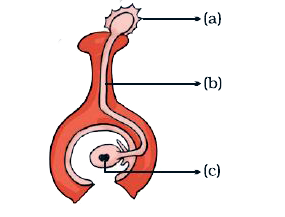Fill in the blanks with correct terms.
The male and female gametes fuse to form _____(a)______during the process of _____(b)______. This grows into an_____(c)______ which is enclosed within a seed. After fertilisation the ovules develop into _____(d)______ and the ovary develops into a _________(e ) ________.
To fill in the blanks in the given statement, we can follow the steps below:
1. Understanding the Process: The question revolves around the process of sexual reproduction in plants, specifically focusing on the fusion of male and female gametes.
2. Identifying the First Blank (a): The male and female gametes fuse to form a zygote. This is the first step in fertilization where the genetic material from both gametes combines.
3. Identifying the Second Blank (b): The process through which the male and female gametes fuse is called fertilization. This is the key event that leads to the formation of the zygote.
4. Identifying the Third Blank (c): The zygote grows into an embryo. The embryo is the early stage of development for the new plant.
5. Identifying the Fourth Blank (d): After fertilization, the ovules develop into seeds. This is a crucial step where the fertilized ovules transform into seeds that can grow into new plants.
6. Identifying the Fifth Blank (e): The ovary develops into a fruit. The fruit is the mature ovary that protects the seeds and aids in their dispersal.
Putting it all together, we have:
The male and female gametes fuse to form (a) zygote during the process of (b) fertilization. This grows into an (c) embryo which is enclosed within a seed. After fertilization, the ovules develop into (d) seeds and the ovary develops into a (e) fruit.
Final Answers:
(a) zygote
(b) fertilization
(c) embryo
(d) seeds
(e) fruit
(a) zygote
(b) fertilization
(c) embryo
(d) seeds
(e) fruit
Topper's Solved these Questions
- REPRODUCTION IN PLANTS BOOK - NCERT EXEMPLARCHAPTER - REPRODUCTION IN PLANTS EXERCISE - Short Answer Questions
3 Videos
- NUTRITION IN PLANTSBOOK - NCERT EXEMPLARCHAPTER - NUTRITION IN PLANTSEXERCISE - Long answer questions
4 Videos
- RESPIRATION IN ORGANISMSBOOK - NCERT EXEMPLARCHAPTER - RESPIRATION IN ORGANISMSEXERCISE - Long Answer Questions
12 Videos
Similar Questions
In the diagram given in Figure 12.2 label the parts marked (a), (b) and (c ).

View SolutionMatch the organisms given in Column I with their mode of nutrition given in Column II.

View SolutionPaheli participated in a 400m race competition held at her school and won the race. When she came home she had mixed feeling so joy and pain as she had cramps in her leg muscles. After a massage she was relieved of the pain. Answer the following questions related to the situation
What can be the possible reasons for the pain in her legs?
View SolutionAfter fertilisation, the ovules develop into (a)____ and the ovary matures into a (b)_____
View SolutionIn plants after fertilization, the ovary develops into fruits and ovules develop into seeds.
View SolutionIn flowering plants , after fertilisation, ovary develops into.............. and ovule matures into ......................:-
View SolutionAssertion: In gymnosperms the seeds that develop post fertilisation are naked. Reason: In gymnosperms ovules are not enclosed by any ovary wall.
View SolutionFollowing double fertilisation, events of endosperm and embryo development, maturation of ovules into seeds and ovary into fruit, are collectively termed as
View SolutionFill in the blanks:
A. ………… is the development of seeds from unfertilised female gamete.
View SolutionAfter fertilization , ovule develops into seed and ovary into fruit .
View SolutionOvules grow into _________ and ovaries into after fertilisation.
View SolutionAfter fertilisation, ovules grow into ....................., and ovaries into......
View SolutionWhat do the following parts of a flower develop into after fertilisation? a) Ovary b) Stamens c) Ovules d) Calyx.
View SolutionMale gamete fuses with ovule to form
View SolutionIn an angiosperm, the ovary develops after fertilisation into (i)______ and (ii)_______ develops into seeds.
View Solution
